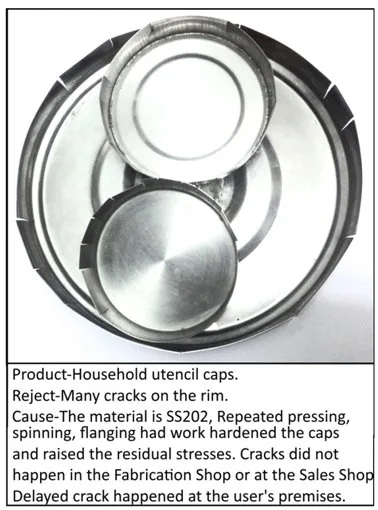SS202 vs SS304
Stainless steel, renowned for its durability, strength, and corrosion resistance, is a widely used material in numerous applications. Among the diverse range of grades available, SS202 and SS304 are two popular choices. Understanding the differences between these two grades can help inform material selection for various projects. This article presents a comprehensive comparison of SS202 and SS304, highlighting their chemical, mechanical, and physical properties, as well as their applications and cost.
SS202 and SS304 are both classified as austenitic stainless steels, but they do have slight differences in their chemical compositions. SS304 mainly consists of 18% Chromium and 8% Nickel, while SS202 contains 17% Chromium and 4% Nickel.
One significant difference is that SS304 uses Nickel, which can be expensive, while SS202 makes use of Manganese. In 2008, when the price of Nickel skyrocketed, SS202 was accepted as a suitable substitute for SS304.
The American Society for Metals (ASM) has recognized over nine types of SS200 series stainless steels. However, the American Society for Testing and Materials (ASTM) has only listed SS201 and SS202.
One drawback of SS202 is its higher carbon content, making it less suitable for critical welding applications. Furthermore, its percentage elongation or ductility doesn’t measure up to SS304.
One significant difference is that SS304 uses Nickel, which can be expensive, while SS202 makes use of Manganese. In 2008, when the price of Nickel skyrocketed, SS202 was accepted as a suitable substitute for SS304.
Read more: A Beginner’s Guide to Welding Grade 202 Stainless Steel
Aesthetically, it can be challenging to differentiate between SS304 and SS202. Some vendors may even claim they are identicalSS202 and SS304 are both classified as austenitic stainless steels, but they do have slight differences in their chemical compositions. SS304 mainly consists of 18% Chromium and 8% Nickel, while SS202 contains 17% Chromium and 4% Nickel.

However, many flanged items, like the caps of utensils that are made from SS202, tend to crack as they age. This demonstrates that despite superficial similarities, there are substantial differences in the performance and durability of SS304 and SS202.
Chemical Properties
The fundamental difference between SS202 and SS304 lies in their chemical composition. The table below lists the key elements and their respective proportions in each grade:
| Element | SS202 (%) | SS304 (%) |
|---|---|---|
| Carbon (C) | 0.15 max | 0.08 max |
| Manganese (Mn) | 7.5-10 | 2 max |
| Silicon (Si) | 1 max | 1 max |
| Chromium (Cr) | 17-19 | 18-20 |
| Nickel (Ni) | 4-6 | 8-10.5 |
| Phosphorous (P) | 0.06 max | 0.045 max |
| Sulphur (S) | 0.03 max | 0.03 max |
| Nitrogen (N) | 0.25 max | 0.1 max |
Key takeaways from the table include:
- SS202 has a higher percentage of Manganese (Mn) than SS304.
- SS304 contains more Nickel (Ni), which enhances its corrosion resistance.
- The carbon content is slightly higher in SS202.
Mechanical Properties
Mechanical properties dictate how a material behaves under different forces and conditions. The table below compares the mechanical properties of SS202 and SS304:
| Property | SS202 | SS304 |
|---|---|---|
| Tensile Strength (MPa) | 515 min | 515 min |
| Yield Strength (MPa) | 275 min | 205 min |
| Elongation (%) | 40 min | 40 min |
| Hardness (HRB) | 95 max | 92 max |
From this table, it’s clear that:
- Both SS202 and SS304 have similar tensile strengths.
- SS202 offers a higher yield strength, making it slightly more resistant to deformation.
- Both grades have similar elongation percentages, indicating comparable ductility.
- SS202 is marginally harder than SS304.
Physical Properties
Physical properties are inherent characteristics of a material, unaffected by external factors. The table below presents a comparison of these properties for SS202 and SS304:
| Property | SS202 | SS304 |
|---|---|---|
| Density (g/cm³) | 7.8 | 8.0 |
| Melting Point (°C) | 1420-1465 | 1400-1455 |
| Thermal Conductivity (W/m·K) | 16.2 | 16.3 |
| Electrical Resistivity (μΩ·m) | 0.69 at 20°C | 0.72 at 20°C |
From the table:
- SS304 has a slightly higher density than SS202.
- The melting point of both grades is quite similar, but SS202 has a slightly higher range.
- Both grades have closely aligned thermal conductivities and electrical resistivities.
Applications
The chemical, mechanical, and physical properties of SS202 and SS304 determine their suitability for different applications.
SS202 is typically used in:
- Domestic appliances
- Automobile body parts
- Building and construction material
SS304, on the other hand, is commonly found in:
- Kitchen utensils and appliances
- Piping and tubing in the food and beverage industry
- Medical and pharmaceutical equipment
Cost
The cost of stainless steel primarily depends on the Nickel content. As SS304 has a higher Nickel content, it is generally more expensive than SS202. However, prices are subject to fluctuations in the global market.
Conclusion
In essence, the choice between SS202 and SS304 depends on the specific requirements of the application. SS202 is a more economical choice with reasonable corrosion resistance and strength, making it suitable for domestic and construction applications.
SS304, with superior corrosion resistance and durability, is ideal for applications in harsh environments, particularly in the food and beverage and medical industries. It’s important to consider these factors, alongside cost implications, when selecting the appropriate grade of stainless steel for your project.





